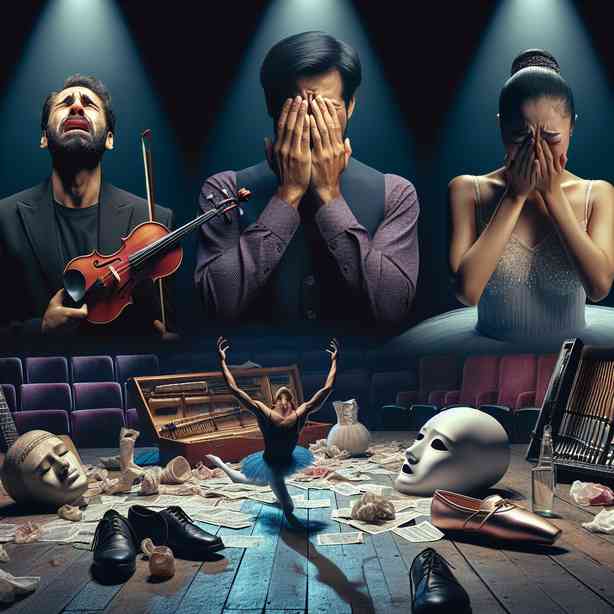
The experience of crying after a good rehearsal is something many performers can relate to, regardless of their level of expertise. This emotional response can often seem puzzling, especially when the rehearsal itself was a positive and fulfilling experience. The tears that follow a successful practice session aren’t always a manifestation of sadness or disappointment; instead, they may arise from a complex interplay of emotional release, connection to the material, and the sheer joy of creative expression.
When we delve into the psychology behind this phenomenon, it’s important to consider how rehearsals serve as a space for vulnerability and exploration. During these sessions, performers often connect deeply with their characters, stories, and the ideas they are trying to convey. This connection can elicit a powerful emotional response. The act of embodying a role or immersing oneself in a piece of music can ignite internal conflicts and joys, tapping into personal experiences or universal themes such as love, loss, and hope. These moments of connection can become overwhelming, resulting in tears as a natural and healthy way to release pent-up emotions.
Moreover, rehearsals often create a sense of camaraderie among the cast and crew. The collaborative nature of theater, music, or dance encourages performers to support and uplift one another. As they share this journey together, moments of triumph during a rehearsal can amplify feelings of gratitude, joy, and relief. When one succeeds, it often feels like a shared success, leading to a collective release of emotions. Sharing laughter and joy with fellow performers can sometimes be even more moving than experiencing it alone, and the culmination of these shared experiences often leads to tears of happiness.
Another contributing factor to this emotional response may be the anticipation of performance. The rehearsal process is not just about practicing lines or music; it’s a preparation for something bigger. When performers realize that they are capable of delivering a powerful performance, the pressure and excitement can culminate in an overwhelming emotional release. The juxtaposition of joy and anxiety throughout the rehearsal process can lead to catharsis, where tears serve as a necessary outlet for those complex feelings. Aware that their work is being solidified and is slowly approaching the public eye can turn rehearsals into powerful emotional experiences.
Furthermore, the act of creativity itself can be deeply tied to emotional expression. Creatives are known for feeling emotions intensely, and engaging in their craft can sometimes lead to feelings surfacing unexpectedly. This phenomenon is sometimes referred to as “emotional contagion,” where one person’s emotions influence another’s, particularly in a collaborative environment. When performers engage deeply with one another, the emotions that arise can influence everyone in the room, leading to moments of collective vulnerability that may culminate in tears.
After a rigorous rehearsal, feeling vulnerable may trigger an urge to cry. Vulnerability is an inherent part of the creative process; it allows performers to share their authentic selves with others. When they find the bravery to express those authentic feelings and dive into the depths of their emotional range, it can be both exhilarating and exhausting. This emotional labor often requires a release, leading to tears as a form of emotional relief.
It’s also essential to acknowledge the role of physical stress in this emotional release. Rehearsals are often physically demanding; whether it’s dance, acting, or playing an instrument, the body works hard and can become fatigued. Physical exertion can produce a flood of endorphins, sometimes blurring the boundaries between joy, relief, and exhaustion. As the body relaxes and the adrenaline wears off, emotions can surface, leading to tears as an honest reflection of both fatigue and accomplishment.
In many ways, the tears shed after a rehearsal can symbolize a blessing in disguise. They serve as reminders of the passion and commitment performers have for their art. These moments of vulnerability highlight the importance of emotional expression within the creative process, allowing for deeper connections to be forged within the group. The tears signal the presence of genuine emotion and can be a valuable aspect of the journey toward performance, making rehearsal more than just a training ground, but a site of profound personal and collective transformation.
Moreover, the tradition of expressing emotions through tears connects with the broader human experience. Seeing others cry during heartfelt moments helps us understand that we are not alone in our struggles and triumphs. This shared emotional experience opens up channels of empathy and understanding, reinforcing the idea that it’s okay to be vulnerable. When individuals cry together, they not only convey the weight of their experiences but also create lasting bonds that can enhance the performance as a whole.
Finally, it’s essential to recognize that crying after a good rehearsal is not something to be ashamed of or hidden. Instead, it should be embraced as a natural part of the artistic experience. Rather than viewing emotions as interruptions, performers can learn to welcome these moments of release as crucial elements of their craft. Emotions fuel creativity, and acknowledging them allows for deeper connections to the material and to one another. Each tear shed becomes a part of the artist’s journey, an essential chapter in the book of their creative life.
In conclusion, crying after a good rehearsal is a multifaceted phenomenon that speaks to the heart of what it means to be a performer. It encapsulates both the emotional depth of the creative process and the power of connection among individuals engaged in a shared pursuit. These tears are a testament to the joys, struggles, and triumphs that come with creating art. Rather than focusing solely on the performance, it’s vital to appreciate the journey—each rehearsal, each tear, and each moment of collective vulnerability plays a role in the larger narrative of artistic expression. Embracing these moments allows performers to fully experience their craft and cultivate a deeper understanding of themselves and their art.


